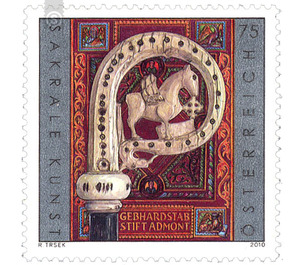Sacred art - Austria / II. Republic of Austria 2010 - 75 Euro Cent
Theme: Art & Culture
| Country | Austria / II. Republic of Austria |
| Issue Date | 2010 |
| Face Value | 75.00 |
| Edition Issued | 250,000 |
| Printing Type | combination printing |
| Stamp Type | Commemorative |
| Item Type | Stamp |
| Chronological Issue Number | 2206 |
| Chronological Chapter | OOS-OE2 |
| SID | 317757 |
| In 54 Wishlists | |
The Benedictine Abbey of Admont, founded in 1074 by Archbishop Gebhard of Salzburg, is the oldest existing monastery in Styria. It lies at the entrance to Gesäuse National Park in an equally impressive and lovable natural landscape. The abbey houses not only the largest monastery library in the world but also a modern museum; In addition, Baroque and contemporary architecture, art from the Middle Ages to the present, as well as early manuscripts and prints, are repeatedly presented in special exhibitions. For centuries, the monastery has not only been the religious center of Upper Styria, but also a center of art and science. In 1120 the monastery was consecrated to a nunnery according to the Benedictine Rule, which was dissolved again in the Reformation. After a varied history and the decline of the monastery, caused by the Turkish wars and the Reformation, brought the Counter-Reformation of the abbey new momentum. Like the bishops and the superiors of the other prelate orders, the abbots of the Benedictine monasteries, on special occasions, especially in festive liturgy, also use the staff as a sign of their dignity and of their ministry and pastoral ministry. The Latin names "Baculus", "Pedum" and "Pastorale" also refer to this ministry, which can be consistently described in German as "shepherd's staff". In the monastery of Admont, such a pastorale has survived as one of the oldest of its kind from the late 12th century; from this time, however, only the parts made of ivory, the curvature ("curva") and the knob ("nodus") come from. The shaft has been replaced by a turned ebony rod as part of a restoration in the 1950s. The crook and knob are undoubtedly made in a carving workshop in the Arab-Sicilian region. The delicate curva tapering in curvature, the diameter of which is barely ten centimeters, was formerly occupied by gemstones; she runs out into an animal's head bent outwards in the opposite direction. In her almost circular closed bow is a slightly damaged winged horse, which carries a finial in its mouth. In a sacristy inventory from 1659 the staff is registered as "Fundatoris Pastorale" ("Shepherd's Staff of the Founder"), which should make him appear as a relic of the founder of the monastery, Archbishop Gebhard of Salzburg. However, he died in 1088. One thing is certain: Similar to the younger "Gebhard-Mitra", we are dealing here with the endeavor to associate a precious liturgical device, regarded as particularly ancient, with the revered person of the founder.


